Drug Catalog - Product Detail
QUETIAPINE FUMARATE TAB ER 24HR 50 MG 60 CT
| NDC | Mfr | Size | Str | Form |
|---|---|---|---|---|
| 16729-0132-12 | ACCORD HEALTHCARE | 60 | 50MG | TABLET |
PACKAGE FILES
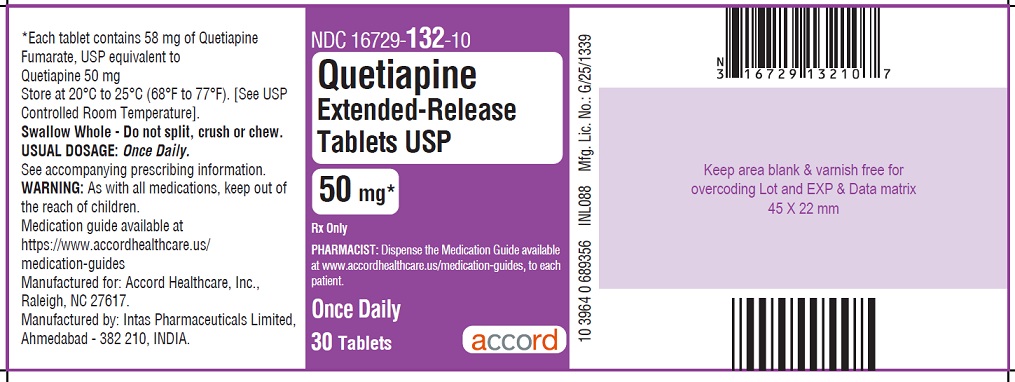
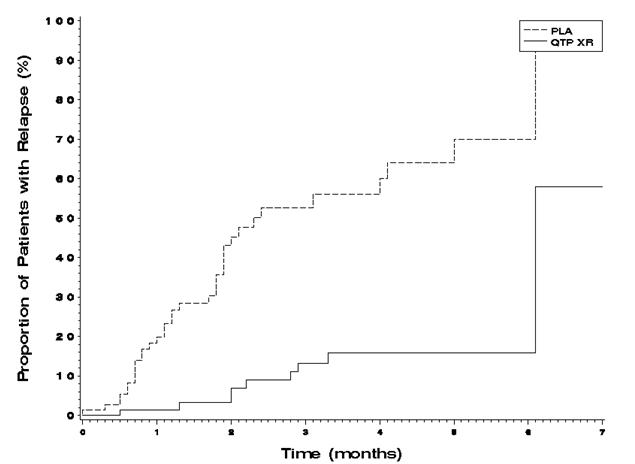
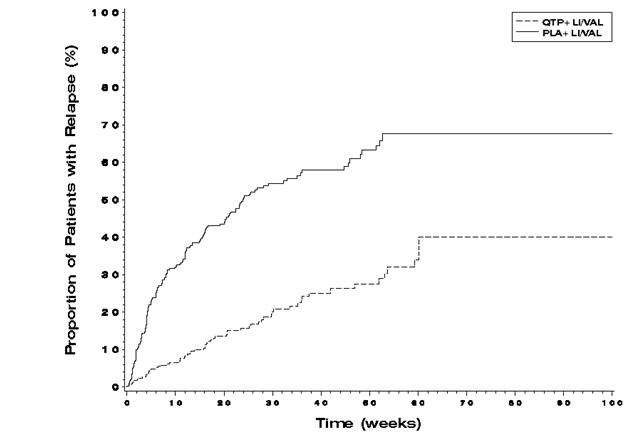
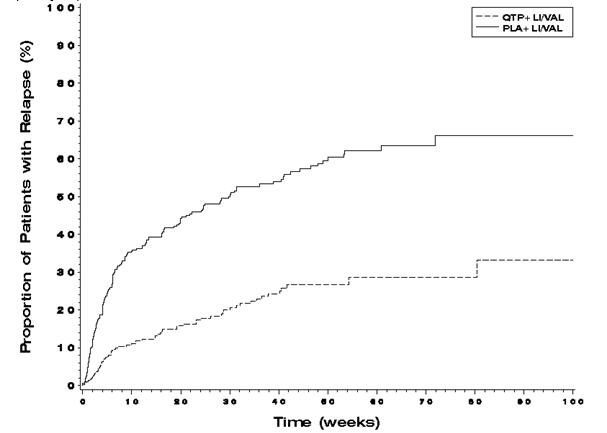
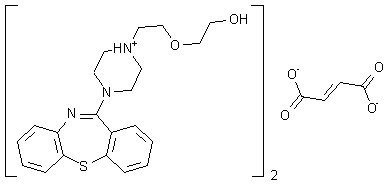
Generic Name
QUETIAPINE FUMARATE
Substance Name
QUETIAPINE FUMARATE
Product Type
HUMAN PRESCRIPTION DRUG
Route
ORAL
Application Number
ANDA206252
Description
11 DESCRIPTION Quetiapine is an atypical antipsychotic belonging to a chemical class, the dibenzothiazepine derivatives. The chemical designation is 2-[2-(4-dibenzo [ b,f ] [1,4] thiazepin-11-yl-1-piperazinyl)ethoxy]-ethanol fumarate (2:1) (salt). It is present in tablets as the fumarate salt. All doses and tablet strengths are expressed as milligrams of base, not as fumarate salt. Its molecular formula is C 42 H 50 N 6 O 4 S 2 •C 4 H 4 O 4 and it has a molecular weight of 883.11 (fumarate salt). The structural formula is: Quetiapine fumarate is a white to off-white crystalline powder which is moderately soluble in water. Quetiapine Extended-release tablets, USP 50 mg are supplied for oral administration as 50 mg (peach, capsule shaped and film coated). Inactive ingredients for quetiapine extended-release tablets, USP 50 mg are hydroxypropyl methylcellulose, lactose monohydrate, magnesium stearate, povidone K30, silicified microcrystalline cellulose, sodium chloride and talc. The film coating contains polyethylene glycol, red iron oxide, yellow iron oxide, talc and titanium dioxide. Each 50 mg tablet contains 58 mg of quetiapine fumarate, USP equivalent to 50 mg quetiapine. Quetiapine Extended-release tablets, USP 50 mg meet USP Dissolution Test 5. structural formula
How Supplied
16 HOW SUPPLIED/STORAGE AND HANDLING Quetiapine Extended-release tablets, USP 50 mg (NDC 16729-132) peach colored, capsule shaped, biconvex, film coated tablets, debossed with ‘AB 1’ on one side and plain on other are supplied in bottles of 30 tablets with a child-resistant closure (NDC 16729-132-10), bottles of 60 tablets with a child-resistant closure (NDC 16729-132-12) and bottles of 1,000 tablets (NDC 16729-132-17). Store quetiapine extended-release tablets, USP 50 mg at 20ºC to 25ºC (68 ºF to 77 ºF). [See USP Controlled Room Temperature].
Indications & Usage
1 INDICATIONS AND USAGE Quetiapine Extended-release tablet is an atypical antipsychotic indicated for the treatment of: Schizophrenia (1.1) Bipolar I disorder, manic, or mixed episodes (1.2) Bipolar disorder, depressive episodes (1.2) Major depressive disorder, adjunctive therapy with antidepressants (1.3) 1.1 Schizophrenia Quetiapine Extended-release tablets are indicated for the treatment of schizophrenia. The efficacy of quetiapine extended-release tablets in schizophrenia was established in one 6-week and one maintenance trial in adults with schizophrenia. Efficacy was supported by three 6-week trials in adults with schizophrenia and one 6-week trial in adolescents with schizophrenia (13 to 17 years) treated with quetiapine tablets [see Clinical Studies (14.1) ]. 1.2 Bipolar Disorder Quetiapine Extended-release tablets are indicated for the acute treatment of manic or mixed episodes associated with bipolar I disorder, both as monotherapy and as an adjunct to lithium or divalproex. The efficacy of quetiapine extended-release tablets in manic or mixed episodes of bipolar I disorder was established in one 3-week trial in adults with manic or mixed episodes associated with bipolar I disorder. Efficacy was supported by two 12-week monotherapy trials and one 3-week adjunctive trial in adults with manic episodes associated with bipolar I disorder as well as one 3-week monotherapy trial in children and adolescents (10 to 17 years) with manic episodes associated with bipolar I disorder treated with quetiapine tablets [see Clinical Studies (14.2) ]. Quetiapine Extended-release tablets are indicated for the acute treatment of depressive episodes associated with bipolar disorder. The efficacy of quetiapine extended-release tablets were established in one 8-week trial in adults with bipolar I or II disorder and supported by two 8-week trials in adults with bipolar I or II disorder treated with quetiapine tablets [see Clinical Studies (14.2) ]. Quetiapine Extended-release tablets are indicated for the maintenance treatment of bipolar I disorder, as an adjunct to lithium or divalproex. Efficacy was extrapolated from two maintenance trials in adults with bipolar I disorder treated with quetiapine tablets. The effectiveness of monotherapy for the maintenance treatment of bipolar I disorder has not been systematically evaluated in controlled clinical trials [see Clinical Studies (14.2) ]. 1.3 Adjunctive Treatment of Major Depressive Disorder (MDD) Quetiapine Extended-release tablets are indicated for use as adjunctive therapy to antidepressants for the treatment of MDD. The efficacy of quetiapine extended-release tablets as adjunctive therapy to antidepressants in MDD was established in two 6-week trials in adults with MDD who had an inadequate response to antidepressant treatment [see Clinical Studies (14.3) ]. 1.4 Special Considerations in Treating Pediatric Schizophrenia and Bipolar I Disorder Pediatric schizophrenia and bipolar I disorder are serious mental disorders, however, diagnosis can be challenging. For pediatric schizophrenia, symptom profiles can be variable, and for bipolar I disorder, patients may have variable patterns of periodicity of manic or mixed symptoms. It is recommended that medication therapy for pediatric schizophrenia and bipolar I disorder be initiated only after a thorough diagnostic evaluation has been performed and careful consideration given to the risks associated with medication treatment. Medication treatment for both pediatric schizophrenia and bipolar I disorder is indicated as part of a total treatment program that often includes psychological, educational and social interventions.
Dosage and Administration
2 DOSAGE AND ADMINISTRATION Swallow tablets whole and do not split, chew or crush (2.1) Take without food or with a light meal (approx. 300 calories) (2.1) Administer once daily, preferably in the evening (2.1) Geriatric Use: Consider a lower starting dose (50 mg/day), slower titration, and careful monitoring during the initial dosing period in the elderly. 2.3 , 8.5 ) Hepatic Impairment: Lower starting dose (50 mg/day) and slower titration may be needed ( 2.4 , 8.7 , 12.3 ) Indication Initial Dose Recommended Dose Maximum Dose Schizophrenia- Adults (2.2) 300 mg/day 400 to 800 mg/day 800 mg/day Schizophrenia-Adolescents (13 to 17 years )(2.2) 50 mg/day 400 to 800 mg/day 800 mg/day Bipolar I Disorder manic or mixed-Acute monotherapy or adjunct to lithium or divalproex-Adults (2.2) 300 mg/day 400 to 800 mg/day 800 mg/day Bipolar I Disorder, manic Acute monotherapy -Children and Adolescents (10 to 17 years) (2.2) 50 mg/day 400 to 600 mg/day 600 mg/day Bipolar Disorder, Depressive Episodes-Adults (2.2) 50 mg/day 300 mg/day 300 mg/day Major Depressive Disorder, Adjunctive Therapy with Antidepressants-Adults (2.2) 50 mg/day 150 to 300 mg/day 300 mg/day 2.1 Important Administration Instructions Quetiapine Extended-release tablets should be swallowed whole and not split, chewed, or crushed. It is recommended that quetiapine extended-release tablets be taken without food or with a light meal (approximately 300 calories) [see Clinical Pharmacology (12.3) ]. Quetiapine Extended-release tablets should be administered once daily, preferably in the evening. 2.2 Recommended Dosing The recommended initial dose, titration, dose range and maximum quetiapine extended-release tablets dose for each approved indication is displayed in Table 1 below. After initial dosing, adjustments can be made upwards or downwards, if necessary, depending upon the clinical response and tolerability of the patient [see Clinical Studies ( 14.1 , 14.2 and 14.3 )]. Table 1: Recommended Dosing for Quetiapine Extended-release tablets Indication Initial Dose and Titration Recommended Dose Maximum Dose Schizophrenia- Adults Day 1: 300 mg/day Dose increases can be made at intervals as short as 1 day and in increments of up to 300 mg/day 400 to 800 mg/day 800 mg/day Schizophrenia-Adolescents (13 to 17 years) Day 1: 50 mg/day Day 2: 100 mg/day Day 3: 200 mg/day Day 4: 300 mg/day Day 5: 400 mg/day 400 to 800 mg/day 800 mg/day Schizophrenia Maintenance-Monotherapy-Adults Not applicable 400 to 800 mg/day 800 mg/day Bipolar I Disorder manic or mixed-Acute monotherapy or adjunct to lithium or divalproex-Adults Day 1: 300 mg/day Day 2: 600 mg/day Day 3: between 400 and 800 mg/day 400 to 800 mg/day 800 mg/day Bipolar I Disorder, manic -Acute monotherapy -Children and Adolescents (10 to 17 years) Day 1: 50 mg/day Day 2: 100 mg/day Day 3: 200 mg/day Day 4: 300 mg/day Day 5: 400 mg/day 400 to 600 mg/day 600 mg/day Bipolar Disorder, Depressive Episodes-Adults Day 1: 50 mg/day Day 2: 100 mg/day Day 3: 200 mg/day Day 4: 300 mg/day 300 mg/day 300 mg/day Bipolar I Disorder Maintenance- Adjunct to lithium or divalproex-Adults Not applicable 400 to 800 mg/day 800 mg/day Major Depressive Disorder- Adjunctive Therapy with Antidepressants-Adults Day 1: 50 mg/day Day 2: 50 mg/day Day 3: 150 mg/day 150 to 300 mg/day 300 mg/day Maintenance Treatment for Schizophrenia and Bipolar I Disorder Maintenance Treatment—Patients should be periodically reassessed to determine the need for maintenance treatment and the appropriate dose for such treatment [see Clinical Studies ( 14.1 , 14.2 )]. 2.3 Dose Modifications in Elderly Patients Consideration should be given to a slower rate of dose titration and a lower target dose in the elderly and in patients who are debilitated or who have a predisposition to hypotensive reactions [see Use in Specific Populations ( 8.5 , 8.7 ) and Clinical Pharmacology (12.3) ]. When indicated, dose escalation should be performed with caution in these patients. Elderly patients should be started on quetiapine extended-release tablets 50 mg/day and the dose can be increased in increments of 50 mg/day depending on the clinical response and tolerability of the individual patient. 2.4 Dose Modifications in Hepatically Impaired Patients Patients with hepatic impairment should be started on quetiapine extended-release tablets 50 mg/day. The dose can be increased daily in increments of 50 mg/day to an effective dose, depending on the clinical response and tolerability of the patient. 2.5 Dose Modifications when used with CYP3A4 Inhibitors Quetiapine Extended-release tablets dose should be reduced to one-sixth of original dose when co-medicated with a potent CYP3A4 inhibitor (e.g., ketoconazole, itraconazole, indinavir, ritonavir, nefazodone, etc.). When the CYP3A4 inhibitor is discontinued, the dose of quetiapine extended-release tablets should be increased by 6-fold [see Clinical Pharmacology (12.3) and Drug Interactions 7.1 )]. 2.6 Dose Modifications when used with CYP3A4 Inducers Quetiapine Extended-release tablets dose should be increased up to 5-fold of the original dose when used in combination with a chronic treatment (e.g., greater than 7 to 14 days) of a potent CYP3A4 inducer (e.g., phenytoin, carbamazepine, rifampin, avasimibe, St. John’s wort etc.). The dose should be titrated based on the clinical response and tolerance of the individual patient. When the CYP3A4 inducer is discontinued, the dose of quetiapine extended-release tablets should be reduced to the original level within 7 to 14 days [see Clinical Pharmacology (12.3) and Drug Interactions (7.1) ]. 2.7 Re-initiation of Treatment in Patients Previously Discontinued Although there are no data to specifically address re-initiation of treatment, it is recommended that when restarting therapy of patients who have been off quetiapine extended-release tablets for more than one-week, the initial dosing schedule should be followed. When restarting patients who have been off quetiapine extended-release tablets for less than one-week, gradual dose escalation may not be required and the maintenance dose may be re-initiated. 2.8 Switching Patients from Quetiapine Tablets to Quetiapine Extended-Release Tablets Patients who are currently being treated with quetiapine tablets (immediate release formulation) may be switched to quetiapine extended-release tablets at the equivalent total daily dose taken once daily. Individual dosage adjustments may be necessary. 2.9 Switching from Antipsychotics There are no systematically collected data to specifically address switching patients from other antipsychotics to quetiapine extended-release tablets, or concerning concomitant administration with other antipsychotics. While immediate discontinuation of the previous antipsychotic treatment may be acceptable for some patients, more gradual discontinuation may be most appropriate for others. In all cases, the period of overlapping antipsychotic administration should be minimized. When switching patients from depot antipsychotics, if medically appropriate, initiate quetiapine extended-release tablets therapy in place of the next scheduled injection. The need for continuing existing extrapyramidal syndrome medication should be re-evaluated periodically.
